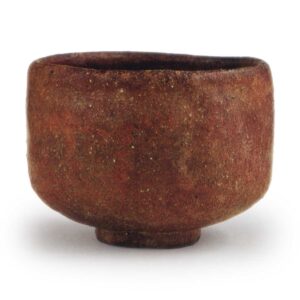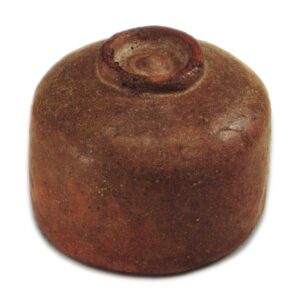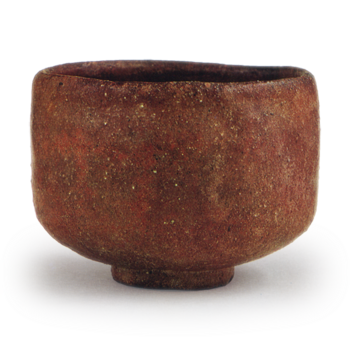

Height: 8.0-8.1cm
Diameter: 10.6cm
Foot diameter: 4.7cm
Height: 0.7cm
Tarobo is one of the famous tea bowls made by Chojiro, and is counted as one of the seven types of Chojiro ware, along with Karitori, Koguro, Kankyo, Ichimonji, Hijiri, and Yokogumo. It is also counted as one of the seven types of new-style ware, along with Kankyo, Taira, Mukiguri, Kaziori, Murasame, and Jirobo.
The clay is a red clay with a high iron content, which has been mixed with small grains of quartz and a considerable amount of fine iron particles. This is then covered in a relatively thin coat of semi-transparent white Raku glaze with a dull sheen, applied to the entire inside and outside of the piece. The glaze has not yet fully melted, so the whole piece has a moist feel, and there are white quartz grains and small black iron grains all over the surface. The reason the glaze has not fully melted is either because there was not enough iron in the clay, or because the firing temperature was too low. Like the Raku ware produced after Noko, the glaze is not yet stable, but this is the charm of Chojiro’s Raku tea bowls.
The overall shape and the way the foot ring stands up from the base are similar to Daikoku, and the shape is neat and simple. As it is handmade, there are finger marks here and there on the body, but the shape is relatively thin and light to hold. However, the fact that it has a lot of waist clay can also be said to be one of the characteristics of Chojiro’s tea bowls. The rim and foot ring are both plain and ordinary, and the feeling that he made it simply and obediently to the orders of Rikyu is well expressed in the style of the bowl.
The inside has a spacious feel, and there is a mirror in the interior, with five small marks. It is likely that a lid rest, incense container, or other small item was placed inside and fired. There are also five marks on the foot ring, and the area around the helmet is indented in a circular pattern.
There are various articles about Tarobo in the “Kokin Meibutsu Ruiju”, “Chaki Meikata Hen”, “Hankoan Chayu Ruso”, “Honcho Toki Zisho”, “Sennichu Kaiko Meibutsu Ki”, “Meibutsu Chawan Shu” and other books, and it is one of the famous works of Chojiro’s posthumous works.
This tea bowl is considered to be the work of the first Chojiro, and is a simple and quiet tea bowl of outstanding quality.
The accompanying box is made of paulownia wood with a plain finish, and on the front is an inscription by Sotan in his own handwriting: “Chojiro red tea bowl, Sotan (signature seal)”. The three characters “Tarobo” on the back are in the handwriting of Yoken, and this is followed by the inscription: “This is a tea bowl that belonged to Rikyu. There is a note written by Sōshitsu (in his own handwriting) on the lid of the outer box, which reads “This is a tea bowl owned by Sōtan, and it has been kept in his possession as a treasured item. The outer box is made of paulownia wood, and there is a note on the lid which reads ‘Taro-bō tea bowl’. There is also a note from the time when Fujimura Yoken sold it to Konoike Michio for 87 ryou and 2 bu in 1697.
Various records show that it was originally made by Chojiro at the request of Tarobo of Atagoyama, and then given to Tarobo, but later passed into the possession of Rikyu, who passed it on to Sotan, who in turn gave it to Fujimura Yoken, who used it frequently. Kon’oike Michioku was also very fond of this tea bowl and often asked if he could have it, but Yoken did not readily agree. However, he was repeatedly asked through Rakuyoshi Zemon, and in the end Yoken gave it to Michioku. Since then, it has been a famous tea bowl in the Konoike family, but after the war it left the Konoike family.



